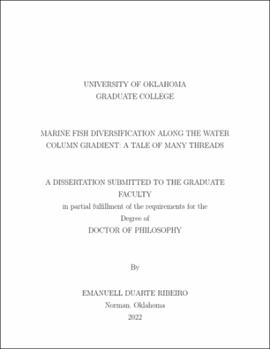| dc.description.abstract | Decades of investigation about the evolutionary mechanisms responsible for the astonishing diversity of fishes have suggested habitat transitions along the water column as a prominent ecological divergence axis affecting morphological and lineage diversification. This process is pervasive across all major freshwater and marine fish clades, and evidence supporting its importance comes from a broad spatiotemporal spectrum. On a narrow scale, recent parallel invasions of freshwater lakes by marine three-spined stickleback populations have repeatedly triggered the evolution of two divergent types: a deep-body form living in association with the bottom (benthic) and a slender-body form found in the water column (pelagic). On the other end of the spectrum, evidence from the fossil record suggests that a significant component of the diversification of spiny-rayed fishes (acanthomorphs) has resulted from the colonization of the ecological space previously occupied by pelagic species that became extinct during the Cretaceous-Paleogene (K–Pg) mass extinction. Nevertheless, despite important progress made on this front, further investigation of the processes associated with benthic-pelagic transitions in a robust phylogenetic framework is necessary for bridging evidence from both ends of the evolutionary continuum.
The overarching goal of my dissertation was to produce comprehensive phylogenomic trees and to use an array of phylogenetic comparative methods (PCMs) to investigate the drivers and the effects of the adoption of habitat regimes in two evolutionarily intriguing and economically important ray-finned fish groups: the family Lutjanidae (ca. 130 species), including snappers and fusiliers; and the series Carangaria (ca. 1090 species), including flatfishes, jacks, marlins, barracudas, remoras, and allies. Additionally, my dissertation provides new evidence supporting the (recently challenged) single evolutionary origin of flatfishes, and used phylogenetically-informed genotype-to-phenotype (PhyloG2P) approaches to identify the molecular mechanisms underlying their asymmetrical development--a key adaptation linked to transitions from pelagic to benthic habitats.
In the first chapter of my dissertation, I applied an integrative approach to quantify the scope and strength of convergent evolution in pelagic lutjanids. As part of a large collaborative effort, I collected genome-wide DNA sequence data for approximately 80% of the total number of species in the group and aggregated data layers for body shape, habitat occupancy, geographic distribution, and paleontological information. The results show that multiple independent colonizations of the water column by ancestrally benthic lutjanid lineages are persistently associated with the convergent evolution of slender bodies and furcate caudal fins. Lineage diversification and transition dynamics vary asymmetrically between habitats, with benthic lineages diversifying faster and colonizing midwater habitats more often than the reverse. These findings demonstrate that convergent phenotypes are ubiquitous among pelagic lutjanids, likely resulting from the strong locomotion constraints imposed by the viscosity of water and drag flow.
For my second chapter, I assessed how transitions along the water column triggered by ecological opportunity in the wake of the Cretaceous-Paleogene (K-Pg) mass extinction shaped diversification dynamics in Carangaria. The results suggest that a remarkable proportion of Carangaria’s morphological variation originated in tandem with a marked incidence of habitat shifts along the benthic-pelagic axis during the Paleocene. Likewise, lineage diversification analyses show that species accumulation rates vary as a function of time, with peaks reached early in the clade’s history. These results indicate that all major lineages and body plans in Carangaria originated in an early burst of evolution shortly after the K-Pg mass extinction, allowing the occupation of newly released ecological niches along the water column gradient.
In my third chapter, I explored the evolutionary origins of the flatfish asymmetric body plan—an extreme evolutionary innovation responsible for the successful colonization and diversification in benthic habitats by carangarian lineages. I analyzed three independent genome-scale phylogenetic datasets, showing that lineage-specific variation in base composition (i.e., base compositional non-stationarity) of exonic markers deeply affects the ability of commonly-used phylogenetic models to resolve flatfishes as monophyletic. This problem can be alleviated, however, by using models that accommodate lineage-specific variation in base composition. The implementation of such models provides decisive support for the single-origin hypothesis of the asymmetric body plan. I also applied models of codon substitution using complete genomes to investigate the molecular bases of the complex phenotypic modifications in flatfishes. The findings corroborate that the flatfish cranial asymmetry results from a complex interaction between thyroid hormones (THs) and other important developmental pathways (e.g., WNT, BMP, RA).
In summary, my analyses demonstrate that ecological divergence along the benthic-pelagic axis greatly impacts rates of morphological and lineage diversification in different clades. Transitions are ubiquitous in time and space but are largely affected by periods of enhanced ecological opportunities, such as the wake of mass extinction events. This process is correlated with the recurrent evolution of convergent body plans but also with some of the most extreme morphological and physiological innovations among vertebrates, such as the internal body temperature regulation (endothermy) in marlins, billfishes, and swordfishes that allows the exploitation of a broad thermal niche, and the flatfish asymmetric body-plan responsible for their successful colonization of the sea bottom. These new insights represent an important step towards understanding the dynamics of animal biodiversity origination in the aquatic realm, ultimately providing a reference to compare against other groups of organisms diversifying along habitat gradients. | en_US |

